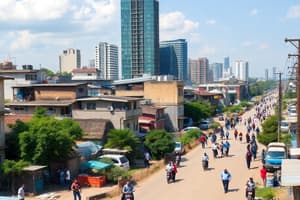Podcast
Questions and Answers
What is a significant impact of flooding on sanitation mentioned in the content?
What is a significant impact of flooding on sanitation mentioned in the content?
- Increase in energy production
- Reduction in water availability
- Overwhelming of treatment facilities (correct)
- Improvement of public health
Inadequate access to water creates positive effects on aquatic systems.
Inadequate access to water creates positive effects on aquatic systems.
False (B)
Name one characteristic of a climate-resilient city.
Name one characteristic of a climate-resilient city.
Functioning public transport systems
_____ is a method to produce energy in Copenhagen that utilizes waste.
_____ is a method to produce energy in Copenhagen that utilizes waste.
Match the following climate response options with their descriptions:
Match the following climate response options with their descriptions:
Which of the following is a push factor that leads to urbanization?
Which of the following is a push factor that leads to urbanization?
Irrigated agriculture accounts for approximately 50% of water withdrawals.
Irrigated agriculture accounts for approximately 50% of water withdrawals.
By 2050, what percentage of the urban population is projected to reach?
By 2050, what percentage of the urban population is projected to reach?
Urban slums often lack access to basic water and __________ services.
Urban slums often lack access to basic water and __________ services.
Match the following water use categories with their corresponding percentages:
Match the following water use categories with their corresponding percentages:
What is one of the primary challenges to urban water management in developing countries?
What is one of the primary challenges to urban water management in developing countries?
Climate change has no significant impact on urban areas.
Climate change has no significant impact on urban areas.
What percentage of water use is dedicated to domestic (potable) use?
What percentage of water use is dedicated to domestic (potable) use?
Flashcards are hidden until you start studying
Study Notes
Urbanization Trends
- The number of people living in urban areas surpassed the number of those living in rural areas in 2008.
- By 2050, the urban population is projected to reach nearly 70%.
- Irrigated agriculture accounts for 70-80% of water withdrawals.
- Industry accounts for 20% of total water use.
- Domestic water (potable) use is approximately 10% of the total.
Push and Pull Factors of Urbanization
- Push Factors:
- Agricultural Challenges:
- Limited employment opportunities due to farming mechanization.
- Environmental factors, like droughts.
- Insufficient land for the growing population.
- Economic Pressures:
- Poor economic conditions.
- Lack of adequate income & subsistence living conditions.
- Resource Scarcity:
- Inadequate access to resources such as water, healthcare, & education in rural areas.
- Disasters and Conflicts:
- Natural disasters that destroy livelihoods.
- Conflicts and wars forcing people to leave rural areas.
- Agricultural Challenges:
- Pull Factors:
- Employment Opportunities:
- Availability of jobs in industrial, service, & technology sectors.
- Better Living Standards:
- Perception of a higher quality of life, including modern housing, better healthcare, and access to goods and services.
- Education:
- Better educational facilities & institutions.
- A wider range of educational opportunities.
- Social Factors:
- Family ties or social networks already established in cities.
- Cultural attractions & lifestyle considerations.
- Healthcare Services:
- More accessible and advanced medical care in urban areas.
- Employment Opportunities:
Urban Water Management Challenges
- Urban Slums/Squatter Settlements:
- Lack of planning and few facilities.
- Little or no access to basic water and sanitation services.
- Without water and sanitation, the SDGs of poverty reduction, environmental sustainability, social development, and gender equality cannot be realized.
- Wastewater Generation:
- Rapid urbanization leads to increased wastewater generation from households, industries, and agriculture.
- Inadequate wastewater treatment infrastructure poses health risks and environmental pollution.
- The Climate Change Challenge:
- Impacts of climate change on water supply:
- Damage to water infrastructure.
- Increasing treatment costs.
- Reduced availability and operational capacity.
- Vulnerability of shallow groundwater systems due to low infiltration and pollution.
- Impacts of climate change on sanitation:
- Damage to sewers.
- Floods overwhelming treatment facilities, increasing public health risks.
- Pollution from pit latrines.
- Increased incidence of diarrhea and respiratory illnesses.
- Impacts of climate change on water supply:
Climate Change Response Options
- Restoration of urban green spaces.
- Understanding climate impacts at a local scale.
- Financing climate resilience in urban settlements.
- Preparing for climate change requires an integrated approach that incorporates economic, social, and environmental interventions.
Characteristics of a Climate Resilient City
- Energy Production and Consumption:
- Move towards cleaner and less carbon-intensive fuels.
- Keep electricity costs affordable.
- Mobility:
- Functioning public transport systems.
- Reduce traffic congestion.
- Manage emissions from transportation and traffic congestion.
- Energy Efficient Design of Buildings:
- Encourage greater use of natural light and ventilation.
- Implement proper insulation.
- Energy conservation measures.
- Forestry Mitigation Activities:
- Create green spaces, such as park areas.
Copenhagen, Denmark as a Climate Resilient City
- Energy Production and Consumption:
- Wind turbines produce energy.
- Powerplant that converts trash into energy.
- Mobility:
- As of 2019, 66% of trips in Copenhagen are made on foot, by bike, or via public transport.
- City Administration:
- Aims to reduce energy consumption in municipal buildings by 40%.
- Buildings are increasingly energy-efficient.
- Alternative fuels are used.
- Solar panels are installed on buildings.
Studying That Suits You
Use AI to generate personalized quizzes and flashcards to suit your learning preferences.




